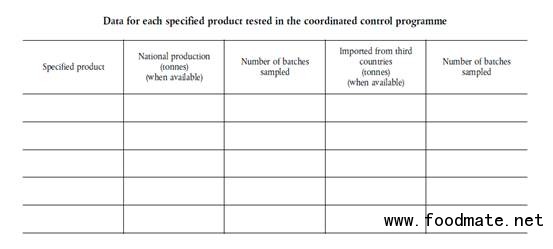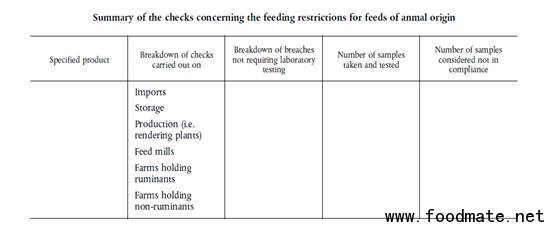THE COMMISSION OF THE EUROPEAN COMMUNITIES,
Having regard to the Treaty establishing the European Community,
Having regard to Council Directive 95/53/EC of 25 October 1995 fixing the principles governing the organisation of the official inspections in the field of animal nutrition(1) and in particular Article 22(3) thereof,
Whereas:
(1) The overall summary report on inspection activities carried out in the field of animal nutrition based on the information provided by the Member States concerning the implementation of the inspection programmes for 1999 does not allow definitive conclusions to be drawn. However, four issues have been identified as worthy of a coordinated programme to be carried out in 2001. In particular reference is made to the need to monitor certain chemical contaminations, certain microbiological contaminations, the respect of Community legislation on anti-microbial growth promoters and the feed ban on certain mammalian proteins (intended to provide protection from transmissible spongiform encephalopathies).
(2) In 1999 and 2000, Member States' inspection services frequently detected contamination of products to be used in animal nutrition with dioxins, PCBs and heavy metals. The above findings, when not included in the control programmes, have been reported to the Standing Committee for Feeding stuffs for discussion and appropriate follow-up.
(3) A salmonella monitoring programme in proteins of vegetable origin was carried out in the period July 1999 to July 2000. While a full assessment of the results is not yet available, the results of only one year of checks may not be a scientifically sound basis on which to present further measures.
(4) A certain number of feed additives can only be used safely when the maximum limits are respected. In addition the use of certain feed additives previously authorised as anti-microbial growth promoters is no longer permitted. However, there is insufficient information on the respect of the maximum limits and on the use of anti-microbial growth promoters.
(5) Each of these matters should therefore be subject to coordinated inspection in 2001.
(6) The deficiencies and failures in the implementation of the ban on feeding ruminants with certain proteins of mammalian origin which led to the adoption of Council Decision 2000/766/EC(2) require a coordinated approach to provide the results of the checks concerning the feeding restrictions for protection from transmissible spongiform encephalopathies.
(7) The measures provided for in this recommendation are in accordance with the opinion of the Standing Committee for Feeding stuffs,
HEREBY RECOMMENDS:
1. Member States should during the year carry out a coordinated monitoring programme aiming to check:
(a) the frequency of occurrence, and concentrations, of the specified contaminants in the specified categories of products to be used in animal nutrition set out in Annex I;
(b) the frequency of occurrence, and levels, of salmonella contamination in feed materials of vegetable origin;
(c) whether conditions for the correct use of substances authorised as feed additives for which maximum levels have been set have been respected;
(d) whether the ban on the use of certain antibiotics as growth promoters has been effectively enforced;
(e) whether all restrictions concerning the production and use of feed materials of animal origin have been respected.
2. In reporting the results of the monitoring programmes, figures on the products concerned should be provided as outlined in Annex II detailing the amounts of national production and imports from third countries.
3. Data on production and imports should be provided even when samples have not been taken and tested.
When laboratory testing is carried out, the methods used and their respective specificity and sensitivity shall be mentioned.
The criteria used in deciding on the compliance upon testing should be reported.
4. The results concerning the feeding restrictions of products of animal origin should be summarised as outlined in Annex III.
5. Member States should include the results of the abovementioned coordinated monitoring programme as a specific chapter in the report on the yearly control activities foreseen by 1 April 2002 in accordance with Article 22 of Directive 95/53/EC.
Done at Brussels, 5 June 2001.
For the Commission
David Byrne
Member of the Commission
(1) OJ L 265, 8.11.1995, p. 17.
(2) OJ L 306, 7.12.2000, p. 32.
ANNEX I
Specific items
- Dioxins (PCDD/F and dioxin-like PCBs) in fish oil, fish meal and fish feed.
- Dioxins (PCDD/F and dioxin-like PCBs) in artificially dried feed materials (hay, alfalfa meal, etc.).
- Dioxins (PCDD/F) in trace elements (zinc oxide, copper oxide, manganese, zinc sulphate, etc.).
- Dioxins (PCDD/F) in minerals (magnesium oxide, phosphates, etc.).
- Heavy metals (Pb, Cd, As, Hg) in trace elements and minerals.
- Heavy metals (Pb, Cd, As, Hg) in fish oil, fish meal and fish feed.
General items
Random monitoring on the presence of dioxins (PCDD/F and dioxin-like PCBs) and heavy metals (Pb, Cd, As, Hg) in feed materials and feedingstuffs.
ANNEX II

ANNEX III















